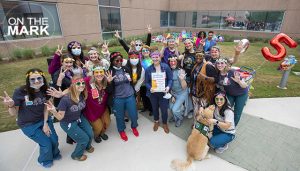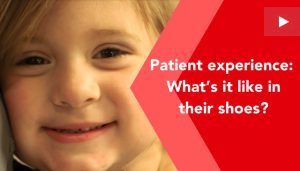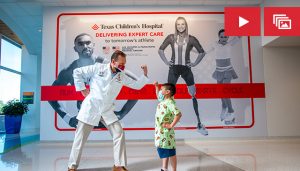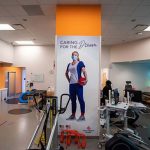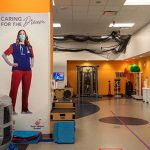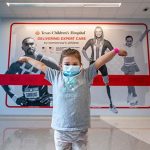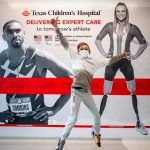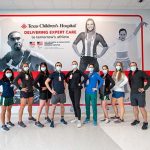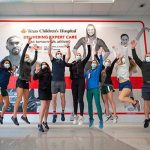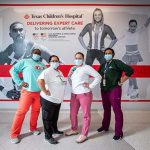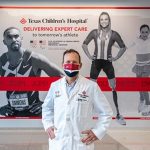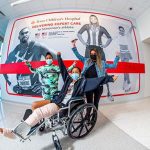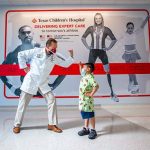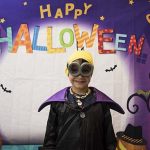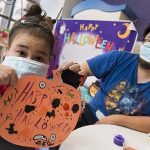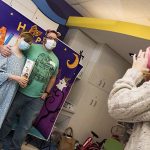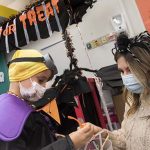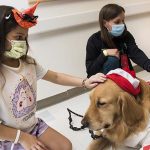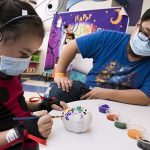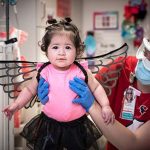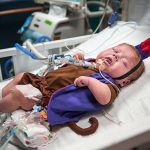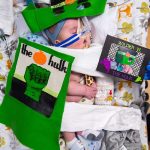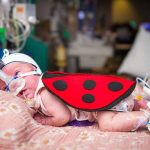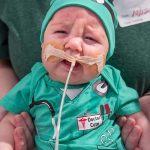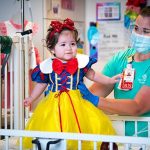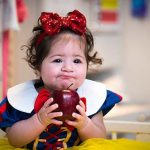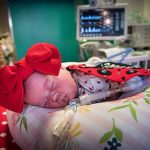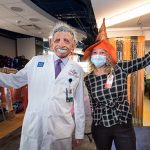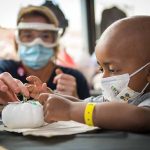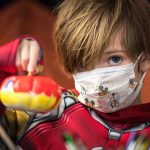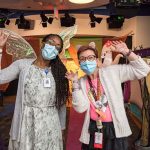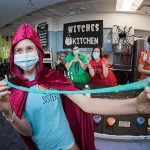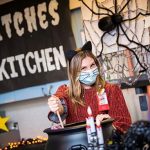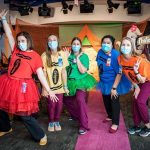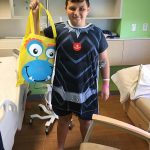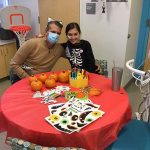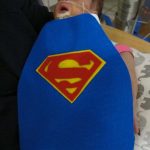This week on Mark Wallace’s blog, he reflects on the decision to bring a pediatric community hospital to families north of Houston and all that has been accomplished in the years since. Read More
Imagine yourself as a member of one of Texas Children’s patient families. You’re longing for someone to listen, wanting to make eye contact or needing help finding where to go the first time you visit our facilities – and that’s on top of worrying about the loved one whose illness or condition brought you there.
Now imagine the difference it would make for you to be heard, comforted and guided with compassion by your care team and other kind and considerate Texas Children’s employees.
Every member of our One Amazing Team has the opportunity to create this type of warm and welcoming environment for our patients and their families every day, contributing to the positive patient experience that is part of the latest People, Performance and Pre-eminence (P³) incentive plan goals.
“At Texas Children’s, how our patients and families experience care with us is central to establishing and continuing a healing relationship with them,” said Katie Kalenda Daggett, Director of Patient and Family Services. “Our commitment to that relationship and to patient-centered care is why patient experience is one of our organizational priorities.”
Why patient experience matters
Families often choose Texas Children’s because they know our global reputation for excellence in pediatric and women’s medical care.
What they don’t always know is whether that care will be part of an engaging and satisfying patient experience, defined by the Beryl Institute as “the sum of all interactions, shaped by an organization’s culture, that influence patient perceptions across the continuum of care.”
Texas Children’s standard for patient experience calls for every interaction to be safe, personalized, present and compassionate.
“Caring for others is the reason many of our team members chose health care as a profession,” said Kalenda Daggett. “Providing a great patient experience is the right thing to do for our patients and their families.”
Studies show that patients who are more engaged in their health care have better clinical outcomes, and engaged team members also report higher levels of job satisfaction and lower levels of burnout and compassion fatigue.
‘We can all make a difference’
Through feedback on surveys and personal interactions with our Patient Experience team, patients and families have shared that one of the most important factors that affect how they feel about Texas Children’s is how well our team members work together to provide coordinated care.
“The staff was friendly and respectful to each other,” said one survey respondent. “They communicated with each other and supported each other. It gave me confidence in their ability to care for my kids.”
Every role counts – from managing the correct Epic templates for documentation to maintaining our website, scheduling appointments, screening visitors, completing registration, cleaning facilities and providing accurate billing. Even stopping to help someone lost in the hallway makes a difference.
“Doctors, nurses, support teams, administrative personnel – we can all make a difference in our patient’s lives,” said Elisa Mozley, Assistant Director of Patient and Family Services. “If something you did has the potential to make some part of a patient’s journey easier, more comfortable or brighter, you’ve done your part well.”
Jessi Carcamo, ambulatory services representative at Texas Children’s Hospital The Woodlands, is a shining example.
“Creating magic for everyone is a passion of mine. I have always found a great sense of gratification to know that I was able to help someone in any way possible, no matter how big or small,” said Carcamo. “Every morning no matter how I may feel I make an effort to make someone smile, a simple smile can turn your whole world around. Seeing someone smile and have just a little better of a day brings me the warm fuzzy feels.”
How you can help
Everyone at Texas Children’s can support patient experience. Here’s how:
- Practice and promote safety, from washing your hands to cybersecurity.
- Personalize the patient’s experiences by calling people by name, making connections and building rapport.
- Be present by making eye contact, removing headphones or earbuds and being alert when walking the halls to pick up trash, help people that are lost and anticipate needs.
- Be compassionate by taking your time with each interaction, putting yourself in someone else’s shoes and communicating understanding and support.
- Watch the video “Patient experience: What’s it like in their shoes?“ featuring our President and CEO Mark A. Wallace and think about his question: “What small thing can we do today and every day to provide outstanding patient care and superb patient services for our families?”
- Visit the Patient Experience Resource Center for tactics and best practices for delivering safe, personalized, present, and compassionate care experiences for our patients and families, and for recognizing and praising our Texas Children’s colleagues.
After Caring for the Dream as the national medical center and Official Pediatric Medicine Provider of the 2021 Summer Olympics and Paralympics games, Texas Children’s is supporting Team USA in the 2022 Winter Games by delivering expert care to the elite athletes of tomorrow.
To kick off the opening of the games in Beijing this month and celebrate our ongoing partnership with the U.S. Olympic & Paralympic Committee (USOPC), Texas Children’s has installed a dynamic new mural at The Woodlands hospital campus.
The wall-sized artwork features Hannah Harrell, Solomon Simmons and Oksana Masters, award-winning athletes representing Team USA and patients of Texas Children’s Hospital. The mural is located close by the Orthopedics and Sports Medicine Clinic – a state-of-the-art facility where practitioners care for and treat acute and chronic sports injuries, concussions, exercise-induced asthma and other conditions affecting sports performance.
Texas Children’s is among the top 12 children’s hospitals in the nation for Orthopedics, according to the 2021-22 Best Children’s Hospitals rankings from U.S. News and World Report.
“As young athletes transition from the playground with the goal of representing Team USA, we look forward to helping them achieve these milestones by providing expert care during an illness or injury, and maintaining their overall health and well-being,” said Dr. Jeffrey Shilt, chief of community surgery and the sports medicine liaison to the USOPC, when Texas Children’s addition to the USOPC National Medical Network was announced.
“We take great pride in being able to support the next generation of Olympians and Paralympians as they optimize their health and performance,” Shilt said.
To check out the mural for yourself and see snapshots of our colleagues and patients at The Woodlands embracing the Olympic spirit, scroll through the photos in the gallery.
For an inside look at how the mural was installed, click here.
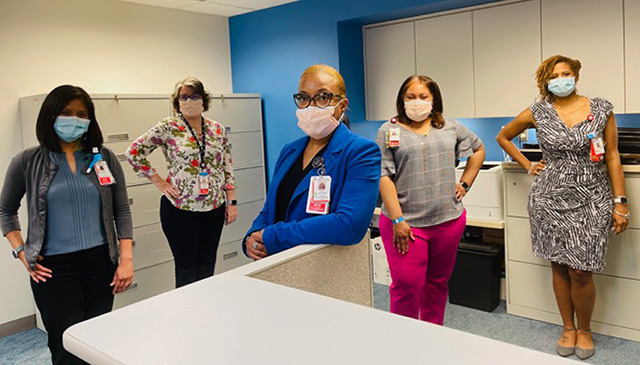
The Smart Pump Interoperability Project recently went live at the Medical Center, West Campus and The Woodlands, thanks to a committed team that pushed forward to bring the innovative technology to Texas Children’s despite disruptions from the ongoing pandemic.
Smart pumps are known to help prevent adverse drug events, especially when linked with electronic health records. These pumps include auto-programming, which allows for specific medications to be transferred directly from a patient’s records to the smart infusion pump, and auto documentation, which allows information like start and stop times to be sent electronically.
To support the project, a total of 2,111 Texas Children’s nurses completed Alaris Interoperability training and gained the skills to improve medication safety and quality practices, and reduce infusion administration errors.
Epic Trainers, Nursing Professional Development Specialists and Clinical Nursing Informaticists collaborated to deploy the training, which was provided as part of nursing education at the system level with the support of Biomedical Engineering, Information Services and Pharmacy. The curriculum included 15 online learning modules with video demonstrations and learner engagement simulations, followed by live hands-on practice.
Additionally, more than 230 nurses served as Interoperability Skill Validators and used the Rover, Alaris pump and Epic EMR integration in an interactive training environment to prepare in-patient and Emergency Center nurses to implement the new practices in time for go-live on January 19 at the Medical Center/Pavilion for Women, and February 9 at West Campus and The Woodlands. Tabletops were conducted with various specialties to assist in preparing clinicians, and a clinical readiness training video was livestreamed with the help of the Simulation Center to give nurses a view of workflows and answer their questions.
Making the project happen
The go-live was implemented in two phases to ensure that nursing staff and those working behind the scenes at each campus would have the necessary support. During the transition at Medical Center/the Pavilion, 233 current infusions were connected to smart pump interoperability. At West Campus and The Woodlands, 35 infusions were connected within just a few hours.
At the center of the effort was the Clinical Subgroup, which drove all decisions and clinical practice. The subgroup consists of clinical nurse specialists and nurse educators from across the organization.
Also instrumental were informatics resource liaisons (IRLs), who worked along with the IS Command Center to help centralize calls surrounding the project. IRLs validated other bedside nurses with hands-on demonstrations; provided necessary feedback related to decision on workflows impacting the project; relayed necessary concerns and information from other bedside staff; and provided hands-on support while maintaining their own patient care load. As trusted liaisons, IRLs communicated problems to IS and communicated their findings and additional information back to their units.
A particular point of pride was the interaction at the unit level, which proved critical to the project’s success. Led by CVICU Clinical Specialist Lauren H. Salinas, nursing staff prepared their units by providing a worksheet to transition their current infusions. At the Pavilion for Women, High- Risk OB Clinical Specialist Tara Barrick and RNC-OB Educator Coordinator Melinda Trussell led the way in validating their staff by adopting the theme, “Operation Interop.”
Praising the project’s success
Nursing staff and vendors who supported the project had plenty had of good things to say about bringing the Smart Pump Interoperability Project to life:
- “It was easier than I thought; we should have done this earlier.” – 14WT RN
- “The modules made this way scarier than it truly was.” She said “I felt like I was going to forget something when it’s actually just 2 more steps to our BCMA process.” – 12WT RN
- “So far, it’s been a smooth transition with no major issues!” – West Campus PICU RN
- “Back association is beautiful where I never have to guess and go all the way back in the MAR then document my fluid. With back association, it all pulls in and do it right there at the bedside with another nurse.” – RN Float Nurse West Campus
- “That is excellent work! The average pumps go live will see organizations hover at around 70% compliance for the first week, so we’re trending above that which is great news.” – Bryan K. (Epic TS)
- “This is the best go-live I have ever supported. Expect some phone calls from our other pediatric customers.” – BD support team
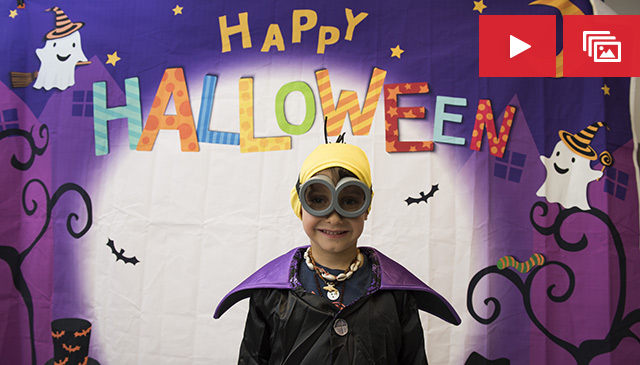
Halloween came early for several patients, their families and employees at Texas Children’s. While the COVID-19 pandemic changed this year’s Halloween celebrations, Child Life teams at our three hospital campuses organized several spooktacular activities while keeping safety and social distance in mind.
At Texas Children’s Medical Center Campus, the festivities began on October 10 in the neonatal intensive care unit (NICU) where our hospital’s tiniest patients celebrated their first Halloween dressed up in costumes that ranged from lady bugs, butterflies and fruit, to super heroes and Disney characters.
Texas Children’s NICU Child Life and Music Therapy team organized the Halloween celebrations with support from the Newborn Center Social Work team and NICU leadership. Due to COVID-19, this year’s celebrations were organized differently to maintain social distancing. Instead of hosting costume decorating parties where parents gathered in a room to make their babies’ costumes, kits were distributed to families so they could make their own Halloween costumes individually.
“We provided materials to create felt layover costumes so that all NICU patients, no matter their medical needs, could participate,” said Child Life Specialist Teaghan Robinson. “Several families used the kits to create costumes for their babies, while other families purchased their own costumes for the occasion. Since the hospital environment can be a difficult place for NICU patients and their families, our team wanted to normalize their experience as they celebrated their baby’s first Halloween.”
For siblings who were unable to visit their newborn brother or sister in the NICU due to hospital visitation restrictions, the NICU Child Life and Music Therapy Team provided Halloween themed picture frame decoration kits for parents to take home with them so their children could also join in on the fun.
Video: Halloween highlights at Texas Children’s
The Halloween festivities didn’t stop there. There were plenty of other Spooktacular events in October:
Child Life Zone Halloween Party: Spirit of Halloween donated costumes to patients and their families for this special occasion. Activities included pumpkin painting, witches slime making, a photo booth, and games. Patients from each floor came up to the Child Life Zone on their designated day to allow for social distancing. Staff from other departments volunteered the event and dressed up in their Halloween best.
Reverse Trick or Treating: Complete with music, games, a photo booth, and COVID-19 friendly trick or treating, a decorated cart filled with Halloween goodies made its way to each patient floor in West Tower. Patients, dressed up in their costumes as they waited eagerly in their room to trick or treat with staff.
Halloween at West Campus: Patients received Disney-themed bags filled with fun activities based on the individual’s age/developmental level. These bags included stuffed animals, Halloween/Autumn coloring or sticker activities, Disney pen and journal, Disney playing cards and books to read.
Halloween at The Woodlands: The Woodlands Campus celebrated Fall Fun Day where staff handed out over 400 bags of fall themed toys and activities to our inpatients and outpatients. Inpatients were able to participate in socially distanced pumpkin painting. The NICU patients were also able to have their First Halloween pumpkin pictures by the Child Life team with the support of First Memories Texas equipment and supplies. The bags and items were generously donated by community partners including: Clariant Oil Services, Junior League of The Woodlands, Arthur J. Gallagher & Co. The Woodlands Fire Department, Klein Cain Mu Alpha Theta, Modern Woodmen of America, National Charity League – Woodlands Chapter, Chick-Fil-A College Park and 501st Legion – South Texas Squad of Star Garrison.
View the photo gallery to get a glimpse of the fun everyone had at these unforgettable events.
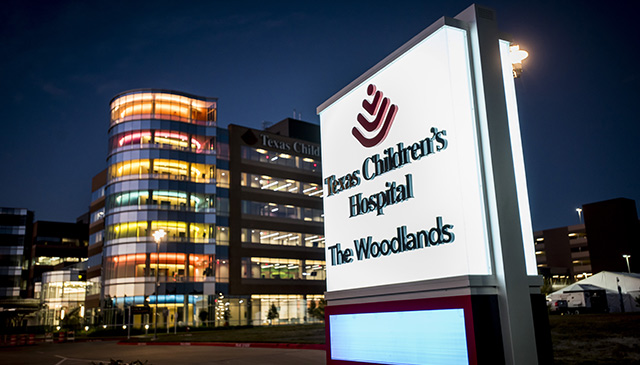
Approximately 25 percent of children and adolescents in the United States have a diagnosed mental, behavioral, learning, or developmental disorder, and these numbers are growing rapidly as more children and families continue to be impacted by the uncertainty, economic stress and daily disruption caused by the COVID-19 global pandemic.
“Since we began building our developmental-behavioral health infrastructure in The Woodlands in 2016, our focus has been on developing a robust program that serves the broad developmental and mental health care and behavioral needs of children and families,” said Dr. Paul Sirbaugh, chief medical officer at Texas Children’s Hospital The Woodlands. “From diagnosis to a multidisciplinary treatment approach, our patients and families can access services in their own community from behavioral health specialists who treat a myriad of mental health issues.”
The Developmental-Behavioral Health team consists of psychiatrists, psychologists, a clinical social worker and a developmental-behavioral pediatrician who collaborate with colleagues at Texas Children’s, Texas Children’s Pediatrics and in the community to design efficient methods to screen and identify patients in need of our services.
Having developmental-behavioral health services available at Texas Children’s provides the security of knowing that children and families will benefit from science-informed practice and a focus on quality and outcomes, ensuring our patients and their families have access to the right care, in the right place at the right time.
Our patient model of care
Referrals to the Developmental-Behavioral Health team at The Woodlands are routed through the Behavioral and Developmental Sciences Referral Center. A dedicated referral team reviews all patient referrals closely and triages them to the appropriate service, location and provider based on the patient’s needs. The developmental-behavioral health providers can also bring other members of the team on board for those patients who would benefit from more than one service.
Psychology
The psychology team in The Woodlands offers diagnostic assessment and psychotherapy intervention services either through in-person or e-Health video visits for children and adolescents with behavioral health concerns.
“Within psychology, our focus is on using evidence-based tools and interventions to diagnose, treat and monitor outcomes for our patients,” said Chief of Psychology Dr. Karin Price. “Our psychology providers work with a broad spectrum of pediatric and adolescent patients including those with common mental health concerns and difficulties related to acute and chronic health issues.”
The Woodlands team consists of four psychologists and a certified social worker with diverse specialties:
- Dr. Elizabeth Franklin treats adolescent patients with mood, anxiety and eating disorders. She also serves as the bariatric surgery psychologist for The Woodlands Bariatric Surgery Program, where she conducts pre-surgical psychological evaluations and assists patients with interventions for binge eating disorders.
- Dr. Jennifer Kazmerski specializes in pediatric behavioral sleep medicine. Working with our Sleep Center, she provides evidence-based therapy services to children and their families for a range of sleep concerns and sleep disorders including behavioral insomnia, nocturnal enuresis and obstructive sleep apnea.
- Dr. Aime Allain provides family-based interventions for common child and adolescent mental health concerns, including anxiety and depression. She counsels patients on relational concerns whether it be helping families manage conflict and/or social relationships in a healthier, more adaptive way.
- Dr. Don Caudle provides neuropsychological assessment for patients with illnesses or injuries that impact their cognitive functioning, helping families and educators understand a child’s strengths and weaknesses, and how to best help them in their daily lives.
- Nikki Adeleke is a licensed clinical social worker who is part of the Traumatic Stress and Resiliency program that provides support and intervention to children and families facing trauma, stress and personal crises.
While psychologists and psychiatrists both specialize in evidence-based diagnostic assessment and treatment planning for patients, Texas Children’s psychiatrists provide more specialization in medication management.
Psychiatry
Under the guidance of Dr. Kirti Saxena, interim section chief of psychiatry at Texas Children’s, the psychiatry team in The Woodlands consists of two psychiatrists Drs. Nabil Guirguis and Humera Danwar, who also see patients through in-person visits or e-Health video visits, making it easier for providers and their patients to connect remotely.
“We have a full case load of patients in our clinic,” said Saxena. “There is a huge demand for children with primary psychiatric needs, but also patients with chronic medical conditions who need psychiatric services. Many of our slots are filled for existing patients, so trying to get new patients in has been challenging for us, but our providers are doing a fantastic job of accommodating as many patients as we can given our current resources.”
Often times, patients with mental health needs may benefit from more than one service. If a patient has been diagnosed with a mood or anxiety disorder, a traumatic brain injury, or is lagging behind in school after a diagnosis of Attention-Deficit/Hyperactivity Disorder (ADHD) – and in addition to psychotherapy – they need medication to manage the symptoms of their illness more effectively, that’s when the expertise of psychiatry comes into play.
“We collaborate with our psychology partners regularly to ensure that we provide the most comprehensive, individualized treatment plan for our patients,” said Danwar. “We also work with colleagues in developmental pediatrics. If we have a patient with autism whose symptoms are not being managed well with other therapies, and medication management is needed, that’s when my expertise is needed to assist with their treatment plan.”
Developmental Pediatrics
The Meyer Center for Developmental Pediatrics at Texas Children’s is the third component of the comprehensive model of care for patients and their families enrolled in the Developmental-Behavioral Health Program in The Woodlands.
Led by Dr. Robert Voigt, the chief of service for the Meyer Center and head of the section of developmental pediatrics in the Department of Pediatrics at Baylor College of Medicine, our developmental-behavioral pediatricians provide medically directed diagnostic consultations for infants, children and adolescents spanning the full spectrum of developmental-behavioral pediatrics – from intellectual disabilities, autism spectrum disorders, and cerebral palsy to learning disabilities, attention-deficit/hyperactivity disorder (ADHD), and motor coordination disorders. The Meyer Center also provides medically directed developmental evaluations for children at increased risk for developmental-behavioral disorders due to prematurity or other neonatal complications, medical conditions such as congenital heart disease, genetic syndromes, or neurologic disorders, or adverse psychosocial experiences.
“Our approach is interdisciplinary and family-centered, and our evaluation considers the individual and collective impact of biological, genetic, environmental and social factors,” said Dr. Candice Allen, the only developmental- behavioral pediatrician at Texas Children’s Hospital The Woodlands. “Our team evaluates each child and works with the family on assessments, team meetings and conferences to develop an individualized treatment program so that every child who seeks our services receives the care and support they need to achieve their highest potential.”
As medical director of the SOAR (High Risk Neonatal Follow Up) Program at The Woodlands, Allen works closely with families to ensure a seamless transition of care following their infant’s discharge from the NICU. Through this program, the infant’s early growth and development are tracked to ensure that any developmental concerns are detected and addressed as early as possible. If developmental concerns arise, The Woodlands team of SOAR Occupational, Physical and Speech therapists are ready and able to provide any therapy services that are needed.
“It’s so critical that our patients are able to readily access all of our developmental-behavioral health services in The Woodlands,” Allen said. “The sooner that a patient’s mental health, neurodevelopmental and/or neurobehavioral concerns are diagnosed and treated early on, the better the long term outcomes will be for the patient and their family.”
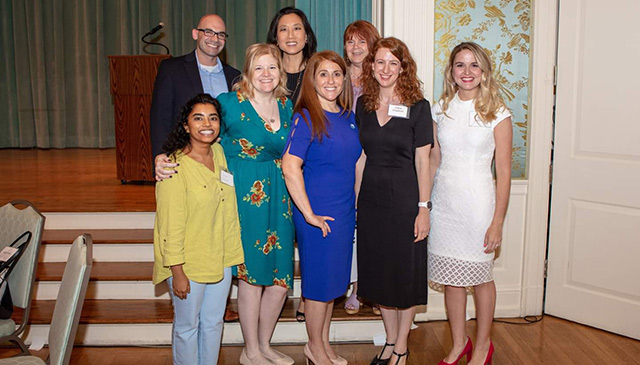
So many teams at Texas Children’s have stepped up in remarkable ways since the COVID-19 pandemic began. The Section of Palliative Care (Pediatric Advanced Care Team) is no different. In fact, this often unsung group has proven its value like never before as families desire more connection, enhanced communication and extended conversation.
The multidisciplinary team of 23 serves Medical Center Campus, West Campus and The Woodlands hospitals.
“We provide an extra layer of support for families and patients who are going through an illness,” said Claire Crawford, palliative care social worker. “We help with non-verbal expressions of compassion in the absence of touch, which has been in exceptionally high demand since the pandemic began.”
Crawford adds that with new visitation guidelines, parents are often alone when they receive news that’s hard to hear. Therefore, there is a need for even more support. “On top of that, our nurses and doctors are often delivering this news while wearing masks, goggles and other protective equipment so it is even more challenging for them to convey their empathy. This is where we come in.”
Crawford says the team can consult with other health care workers to ensure that dialogue with families is compassionate and connective.
In addition, the goals of the department are to:
- Provide emotional support for children and families
- Provide support for difficult hospitalizations
- Manage distressing symptoms
- Engage social work resources
- Help families make difficult decisions
- Refer to supportive therapies (psychology, music therapy, art therapy, and Pawsitive Play) for patients
- Enhance quality of life
- Utilize integrative medicine techniques
Doesn’t palliative care mean “end of life?”
One of the department’s main goals is to educate our patient population on their role and to debunk the myth that palliative care always means that a child may die. “It is true that our services in an adult setting often do mean that the end of life is near, but that is far less the case in a pediatric setting,” said Crawford. “Of course, there are times when we do need do have those discussions, but we are working hard to make sure that when parents hear our name they don’t automatically assume the worst.”
A Texas Children’s dream team
This all-star team is led by Dr. Tammy Kang, section chief of Palliative Care and consists of palliative care specialists, including:
- Doctors
- Nurses and nurse practitioners
- Social workers
- Chaplain
- Grief and bereavement specialist
- Administrators
- Psychologist
- Researchers
Crawford said the success of the team is built on respect for one another, friendship and an unyielding dedication to provide the best care to patients.


